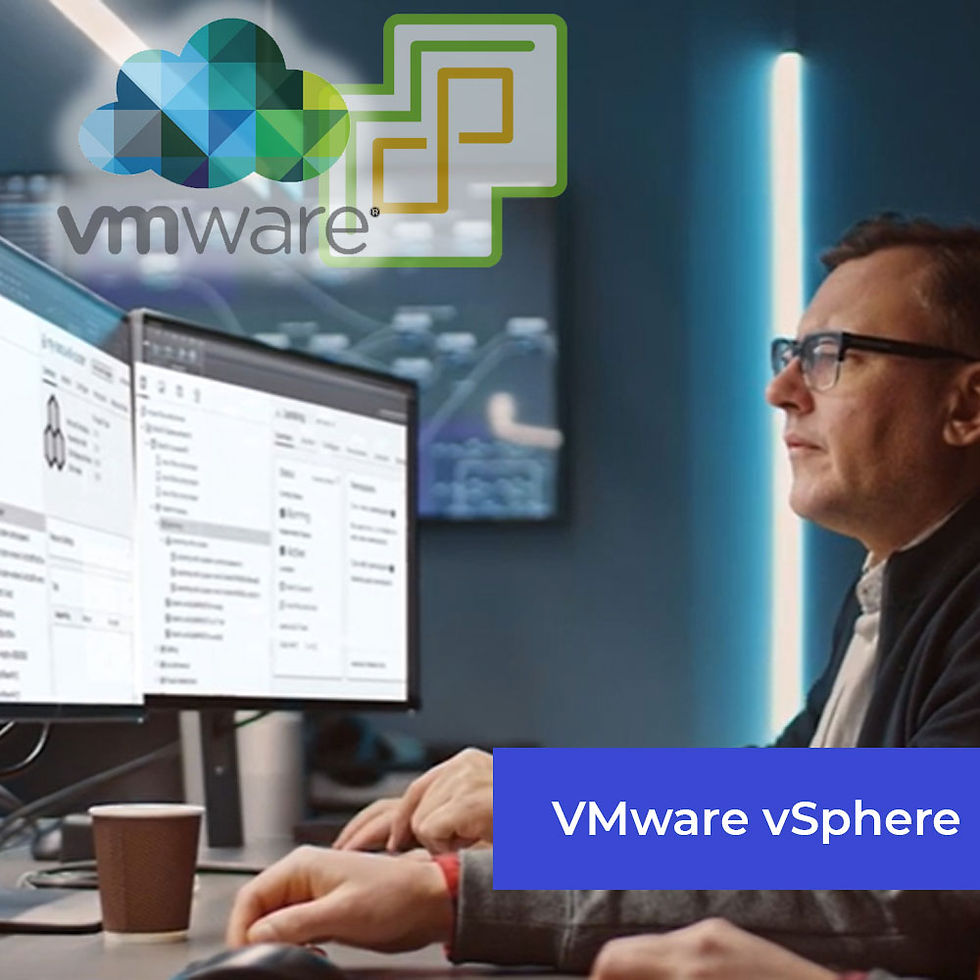CONTENIDO
IMPORTANTE: Este curso está basado en un curso oficial de VMWARE, por lo que lo prepara de una manera óptima para tomar el examen de certificación.
Módulo 1 Course Introduction
- Introductions and course logistics
- Course objectives
Módulo 2 Introduction to vSphere and the Software-Defined Data Center
- Explain basic virtualization concepts
- Describe how vSphere fits into the software-defined data center and the cloud infrastructure
- Explain how vSphere interacts with CPUs, memory, networks, and storage
- Recognize the user interfaces for accessing the vCenter Server system and ESXi hosts
- Describe the ESXi host architecture
- Navigate the Direct Console User Interface (DCUI) to configure an ESXi host
- Recognize ESXi host user account best practices
- Install an ESXi host
- Use VMware Host Client™ to configure ESXi host settings
- Describe how to proactively manage your vSphere environment using VMware Skyline
Módulo 3 Virtual Machines
- Create and provision a virtual machine
- Explain the importance of VMware Tools™
- Install VMware Tools
- Identify the files that make up a VM
- Recognize the components of a VM
- Recognize virtual devices supported by a VM
- Describe the benefits and use cases for containers
- Identify the parts of a container system
Módulo 4 vCenter Server
- Describe the vCenter Server architecture
- Discuss how ESXi hosts communicate with vCenter Server
- Deploy and configure vCenter Server Appliance
- Use the vSphere Client to manage the vCenter Server inventory
- Add data center, organizational objects, and hosts to vCenter Server
- Use roles and permissions to enable users to access objects in the vCenter Server inventory
- Back up vCenter Server Appliance
- Monitor vCenter Server tasks, events, and appliance health
- Use vCenter Server High Availability to protect a vCenter Server Appliance
Módulo 5 Configuring and Managing Virtual Networks
- Create and manage standard switches
- Describe the virtual switch connection types
- Configure virtual switch security, traffic-shaping and load-balancing policies
- Compare vSphere distributed switches and standard switches
Módulo 6 Configuring and Managing Virtual Storage
- Identify storage protocols and storage device types
- Discuss ESXi hosts using iSCSI, NFS, and Fibre Channel storage
- Create and manage VMFS and NFS datastores
- Explain how multipathing works with iSCSI, NFS, and Fibre Channel storage
- Recognize the components of a VMware vSAN™ configuration
Móduo 7 Virtual Machine Management
- Use templates and cloning to deploy new virtual machines
- Modify and manage virtual machines
- Create a content library and deploy virtual machines from templates in the library
- Use customization specification files to customize a new virtual machine
- Perform vSphere vMotion and vSphere Storage vMotion migrations
- Describe Enhanced vMotion Compatibility
- Create and manage virtual machine snapshots
- Examine the features and functions of VMware vSphere® Replication™
- Describe the benefits of vSphere Storage APIs – Data Protection
Módulo 8 Resource Management and Monitoring
- Discuss CPU and memory concepts in a virtualized environment
- Describe what overcommitment of a resource means
- Describe methods for optimizing CPU and memory usage
- Use various tools to monitor resource use
- Create and use alarms to report certain conditions or events
Módulo 9 vSphere Clusters
- Describe the functions of a vSphere DRS cluster
- Create a vSphere DRS cluster
- Monitor a vSphere cluster configuration
- Describe options for making a vSphere environment highly available
- Explain the vSphere HA architecture
- Configure and manage a vSphere HA cluster
- Examine the features and functions of VMware vSphere® Fault Tolerance
- Describe the function of the vSphere® Cluster Service
Módulo 10 Network Scalability
- Configure and manage vSphere distributed switches
- Describe how VMware vSphere® Network I/O Control enhances performance
- Explain distributed switch features such as port mirroring and NetFlow
Módulo 11 vSphere Lifecycle Management
- Recognize the importance of vCenter Server Update Planner
- Describe how VMware vSphere® Lifecycle Manager™ works
- Describe how to update ESXi hosts using baselines
- Validate ESXi host compliance using a cluster image
- Describe how to upgrade VMware Tools and VM hardware
- Describe VMware vSphere® Lifecycle Manager™ and VMware vSAN™ integration
Módulo 12 Host and Management Scalability
- Use host profiles to manage ESXi configuration compliance
- Create and manage resource pools in a cluster
- Describe how scalable shares work
Módulo 13 Storage Scalability
- Explain why VMware vSphere® VMFS is a high-performance, scalable file system
- Explain VMware vSphere® Storage APIs - Array Integration, VMware vSphere® API for Storage Awareness™, and vSphere APIs for I/O Filtering
- Configure and assign virtual machine storage policies
- Create VMware vSAN™ storage policies
- Recognize components of the vSphere Virtual Volumes architecture
- Configure VMware vSphere® Storage DRS™ and VMware vSphere® Storage I/O Control
VMware vSphere: Instalar, Configurar y Administrar vSphere 7
Este curso completo lleva desde la introducción a las habilidades de administración avanzadas de VMware vSphere® 7. Sobre la base del contenido de instalación y configuración, también desarrollará las habilidades avanzadas necesarias para administrar y mantener una infraestructura virtual escalable y de alta disponibilidad.
Con el curso y los laboratorios prácticos, instalará, configurará y administrará vSphere 7. Explorará las características que crean una base para una infraestructura verdaderamente escalable y analizará cuándo y dónde estas características tienen el mayor efecto.
Este curso lo prepara para administrar una infraestructura de vSphere para una organización de cualquier tamaño utilizando vSphere 7.


